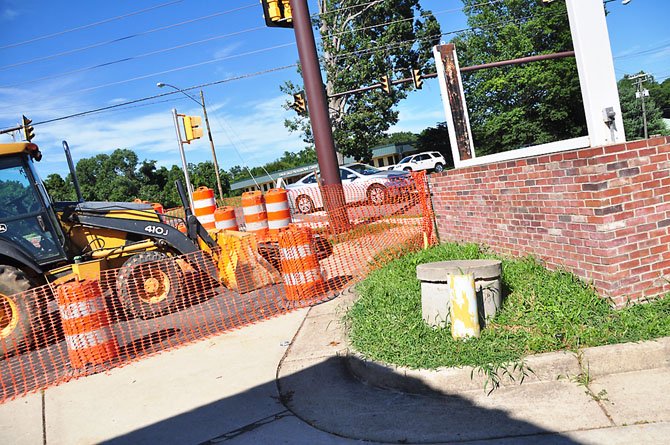The potable well at the former Great Falls Exxon station has tested positive for MTBE, a gasoline constituent, and a plan for remediation is currently being formulated. Photo by Alex McVeigh.
Great Falls — A corrective action plan (CAP) addressing the remediation of gasoline constituents in the ground underneath the property of the former Great Falls Exxon station is in the final stages of preparation.
The Virginia Department of Environmental Quality was informed in August 2009 of the presence of gasoline constituents in the potable well on the property, specifically, methyl tertiary-butyl ether (MTBE).
By March 2010, site analysis, as well as monitoring of nearby properties began, with the eventual goal to produce the corrective action plan. Kleinfelder, an architecture, science and engineering firm, was hired by Fairfax Petroleum, owners of the site, to prepare the report, which must then be approved by the Virginia DEQ.
"Basically we’re going in there with the idea that the CAP is how we’ll solve the problem," said Kurt Kochan, a remediation specialist with the DEQ. "Our goal is to protect human health and the environment, and in this case, that’s defined as protecting all the potable wells."
They are currently monitoring wells onsite, as well as other sites within a quarter-mile of the station. Kochan said that, despite some concerns from the community, the radius of testing will not be expanded beyond a quarter mile.
"We have not discussed expanding the radius. If something in the data suggests a need, we will," he said. "But based on what we’re seeing, we feel we are monitoring a reasonable amount of wells."
THE EXCEPTION is the wells immediately south of the station, whose owners have not given permission for the wells to be tested.
"We have been denied access to the wells immediately surrounding the property to the south," said Mark Steele, an environmental scientist with Kleinfelder. "We can’t get that data as of right now, so the CAP will have holes in it. We were also denied access to the property at the northeast of the intersection, so it won’t be in the CAP, but it could be added in the future."
Steele did say that what they have seen so far indicates that contamination is not spreading.
"We have seen declining MBTE numbers in the onsite wells, which we think may be due to natural attenuation," he said. "Because we haven’t seen high numbers in the offsite wells, we feel that could be the case."
Jeff Hale, a hydrologist with Kleinfelder says so far, the data is promising.
"The fact that we haven’t seen detections in the receptor wells is favorable," he said. "But we’re not hanging our hat on that, which is why the CAP is going to have a plan for remediation. … We know we had a release at the station, and we’re examining pathways by which the contamination could spread. We’re looking at lateral pathways, as well as ones within the bedrock, and they will be fully fleshed out with the release of the CAP."
Kochan said that the reason they are pushing for the report in the absence of access to certain properties is so the remediation can begin as soon as possible.
"There is a sense of urgency in getting the CAP in, because it never hurts to reduce the contaminants that are in the ground," he said.
MEMBERS OF THE COMMUNITY had expressed concern that one of the remediation options would be to simply flush the site with water, thereby diluting and eventually flushing the MTBE.
Cynthia Sale, regional remediation manager with DEQ said that though they do not have the draft report yet, pumping and dilution "is not an option."
Kochan pointed out that the CAP is a "living document," things can be adjusted as needed should more data become available, such as new access to properties south of the station.
"When the report is approved, we will still receive quarterly reports," he said. "In fact, there will be testing of the 23 potable wells Aug. 14 and 15, done by a state contractor, to give us the latest data."
Hale said he expected the CAP would be completed "in the coming weeks," most likely shortly after Labor Day. The Great Falls Citizens Association’s newly formed committee on the matter will be presented with a draft, and will give a few comments over a period of no more than two weeks.
Any needed changes will be made, and then there will be a 30-day public comment period on the report.
The GFCA’s special committee was formed earlier in the summer, in order to engage the stakeholders prior to the release of the report, and they will coordinate public meetings and comment during the review process.
Members of the committee are currently compiling a FAQ document about the process, and once the answers are received, it will be posted on the GFCA website.

